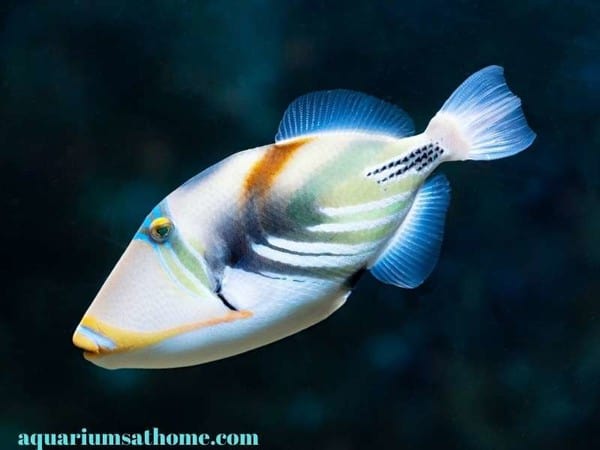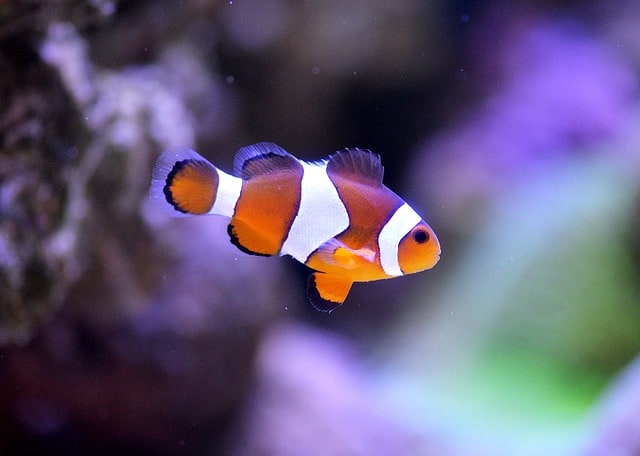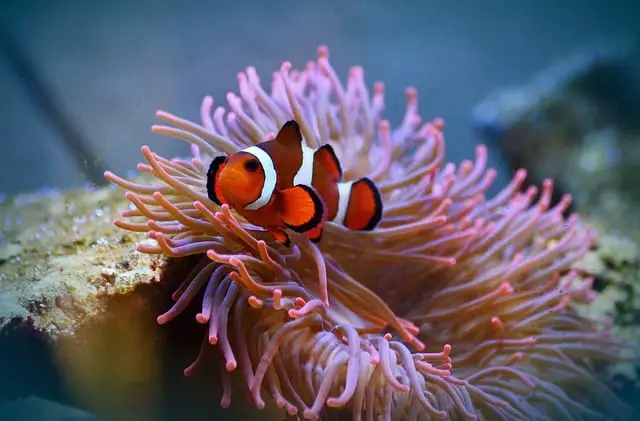Damsels are a great addition to any saltwater aquarium. Their active nature and brilliant coloring make them a pleasure to observe. They’re also hardy, easy to feed, and can tolerate less-than-ideal water conditions. If you’re interested in keeping damselfish, you may be wondering which species make the best tankmates? Well, I have the answer for you…
Damsels do well in a species-only environment. However, if you want to keep them in a community tank, then you should house them with other semi-aggressive species like angelfish, clownfish, and triggerfish (for example). The temperament, size, and social behavior of your damselfish will also determine which aquatic creatures can be considered as potential tankmates.
Now that you know semi-aggressive species make the best tankmates for damselfish, let’s explore this topic further and in more detail. Together we’ll explore the various types of damselfish and learn which species of saltwater fish go well them. We’ll also discover what makes damsels so aggressive in captivity and what to do to lessen that aggression.
So, if you’re ready to learn more about how to stock a saltwater tank with damselfish, then let’s dive in!
Can Damselfish Live with Angelfish?
Dwarf angelfish are quite compatible with starck, talbot, and yellowtail damselfish in a community tank environment. They share a similar semi-aggressive temperament and grow to be about the same size. When housing angels with damsels, make sure not to overcrowd the tank as this leads to heightened aggression in both fish.
Can Damselfish Live with Clownfish?
As clownfish are a sub-species of damselfish, they can co-habitat with other damsels of similar size and temperament in a community tank environment. Blue and green chromis fish make great tankmates for percula or ocellaris clownfish as they tend to be less aggressive in nature. The key is to get clowns and damsels established in the tank while young so they can grow up together.

Can Damselfish Live with Triggerfish?
Triggerfish tend to be more aggressive in nature and therefore, need to be housed with smaller, faster, more vigilant fish of like temperament – namely the damselfish. In an extra-large tank with plenty of space to claim territory and hide, if need be, these two fish can live quite amicably together. Consider less-hostile triggers like the red-toothed or odonus niger as potential tankmates for damsels.
What are the Best Tankmates for Azure Damselfish?
Azure damsels are among the most peaceful damselfish and can be kept in a species-only tank or with other fish of like temperament. Dartfish, gobies, and wrasses make great tankmates for azures – who are best kept in small groups or mated pairs in a community environment. Never keep azures with larger, predatory fish are they’re bound to get eaten!
What are the Best Tankmates for Blue Devil Damselfish?
Blue devil damselfish are among the most aggressive of their species. Therefore, they need to be kept in male/female pairs with larger fish that hold their own such as angels, butterflies, and groupers. Potential tankmates must be chosen carefully as blue damsels are known to harass much larger fish, especially when they invade their territory.
What are the Best Tankmates for Domino Damselfish?
Highly aggressive in nature, domino damsels may be small but will chase after fish twice their size should they feel their territory is being invaded or their offspring are under attack! They’re best kept in small groups in a species-only tank or with other fish of similar temperament including angelfish, dottybacks, and puffers.
What are the Best Tankmates for Neon Velvet Damselfish?
Neon velvet damsels are similar in temperament to dominos and as such, can also be kept with other aggressive fish like angels, dottybacks, and puffers. Providing them with plenty of tank space will help keep their aggression at bay. Best kept alone or as a mated pair, neon velvets will group together as juveniles in captivity but become solitary once they reach adulthood.
What are the Best Tankmates for Sergeant Major Damselfish?
Moderately sized and semi-aggressive in nature, sergeant major damsels should be kept with bigger fish of similar temperament. Large angelfish, dottybacks, and tangs are examples of potential tankmates to consider. Bear in mind that the tank you choose must be very large (at least 100-gallons) when housing fish of this size and demeanor.
What are the Best Tankmates for Starck Damselfish?
Starck damsels are much like sergeant majors in that they’re both moderately sized and semi-aggressive. Therefore, they can dwell with other larger fish of like temperament including angelfish, clownfish, and hawkfish. A solitary fish when in captivity, starck damsels are best kept alone or in a mated pair in a community tank environment.
What are the Best Tankmates for Striped Damselfish?
Two-, three-, and four-striped damsels are much like other damselfish in that they become increasingly aggressive with age as well as during the mating season. Less aggressive tankmates and other smaller damsels won’t fair well in a captive environment with striped damsels, hence they should be housed with angelfish, clownfish, and triggerfish. They’re best kept in small groups in a large, species-only tank.
What are the Best Tankmates for Talbot Damselfish?
Talbot damsels are less aggressive than most damselfish and as such, can be kept with other semi-aggressive fish like percula, ocellaris, and pink skunk clownfish. Very active in nature, talbot damsels may be small, but can get territorial as they reach sexual maturity. Keeping them in mated pairs in a 30-gallon tank minimum will give these fish the space they need to keep tension levels at bay.
What are the Best Tankmates for Yellowtail Damselfish?
Yellowtail damsels are less hostile than their blue devil cousins but can still get territorial in a crowded captive environment. Therefore, they should be housed in a large tank with a reef set-up containing other semi-aggressive fish. Possible tankmates include clownfish, dottybacks, and wrasses. When kept in a mated pair, this species can do quite well in a community tank.

Why are Damselfish so Aggressive in Captivity?
Damselfish are extremely territorial which is why they’re so aggressive in a captive environment. Limited aquatic space increases the stress level of this fish, resulting in drastic measures taken to protect its area or ‘home’. During the breeding season, its innate instinct to protect its offspring at all costs will lead it to viciously attack (often battering to death) any creature that dares to come close!
How to Make Damselfish Less Aggressive in Captivity?
To make damsels less aggressive in captivity, you should keep them in a large, species-only tank with lots of live rock and decorations. These act as hiding place and provide both shelter and security for fish. The extra space allows each damselfish to claim its own territory so there’s less chance of hostility between tankmates.
Keeping damsels in small groups of 3 to 4 will also help lessen aggression. More than 1 male in the tank will lead to hostility and fighting for dominance over the females during the breeding season. Therefore, I recommend keeping just a single male with 2 or 3 females or a female-only environment. If you have your heart set on a community tank, them you must stock it with fish of like size and temperament.
Conclusion
Damsels do well in a species-only environment when in captivity. Should you intend to keep them in a community tank with other fish, then you must consider size, temperament, and social behavior. Other semi-aggressive fish like angels, clowns, and triggers make good tankmates for damsels. The key is not to overcrowd the tank while ensuring it also has plenty of live rock and decorations for cover.
I trust this article has answered your questions on how to best stock a saltwater tank with damselfish. Thanks for reading and best of luck with your aquarium hobby.
Related Posts
Why are Damselfish so Aggressive? (Which One Bites?)
Are Blue Tangs Difficult to Keep?
Are Yellow Tangs Hard to Keep?




